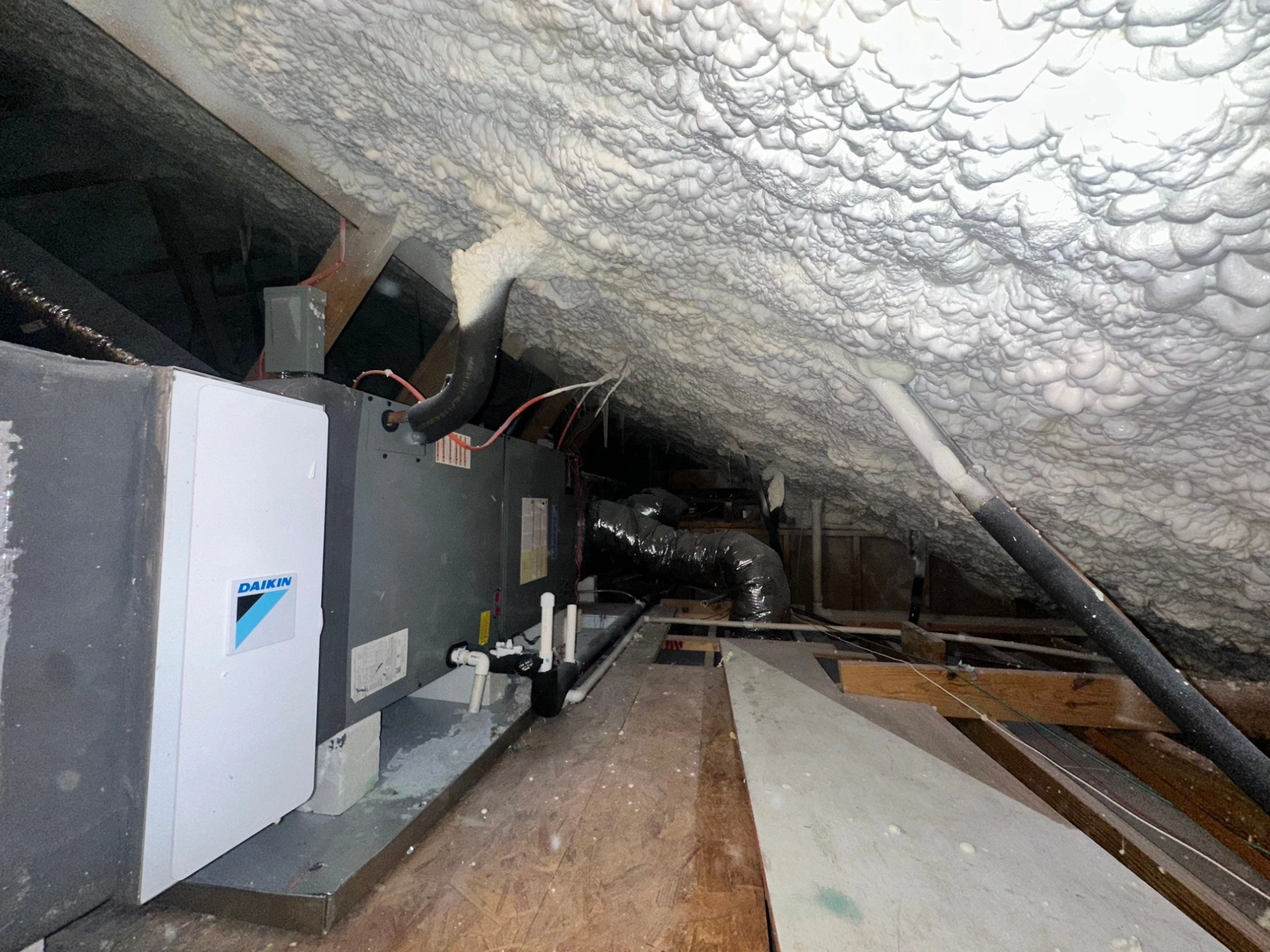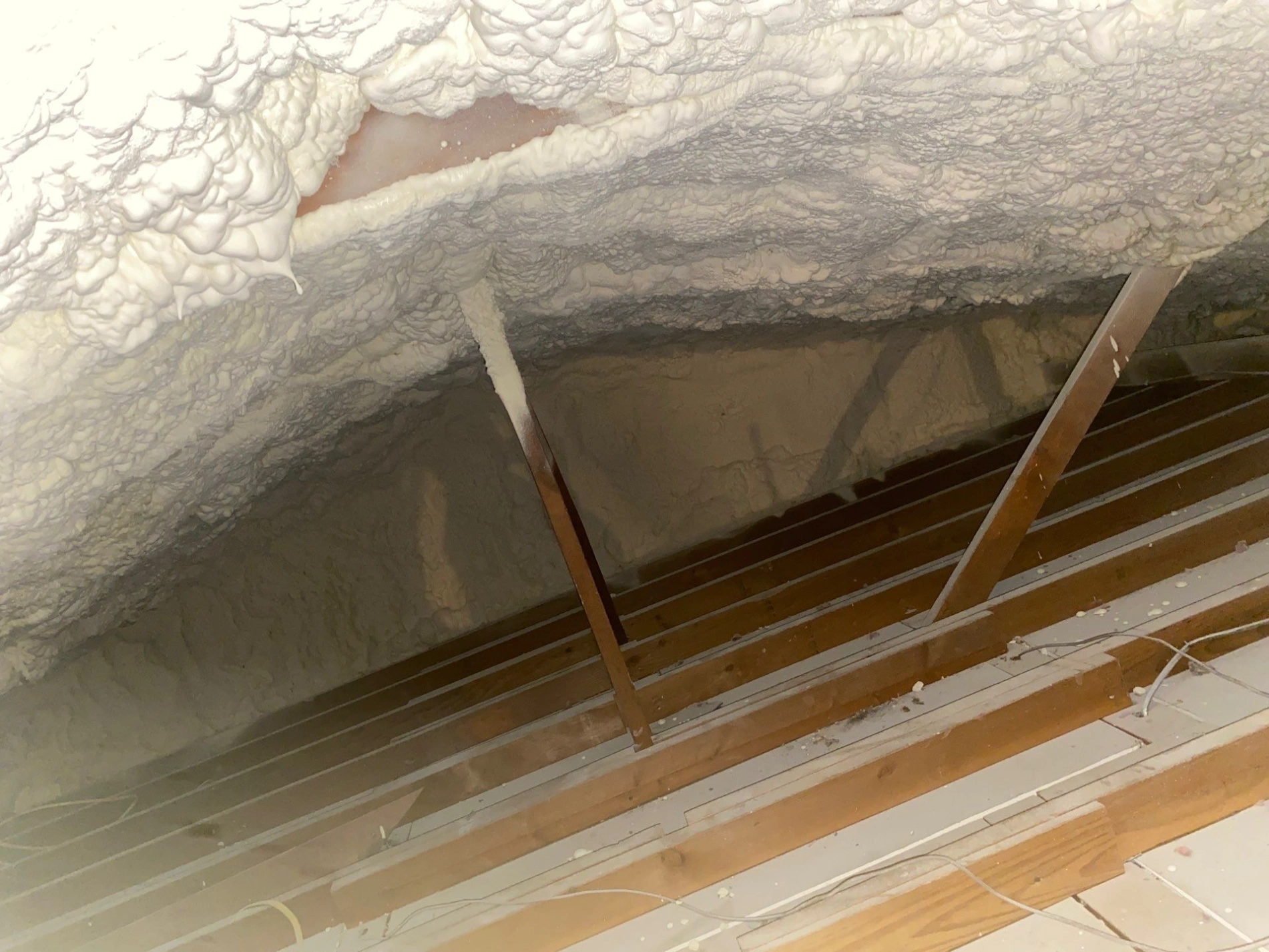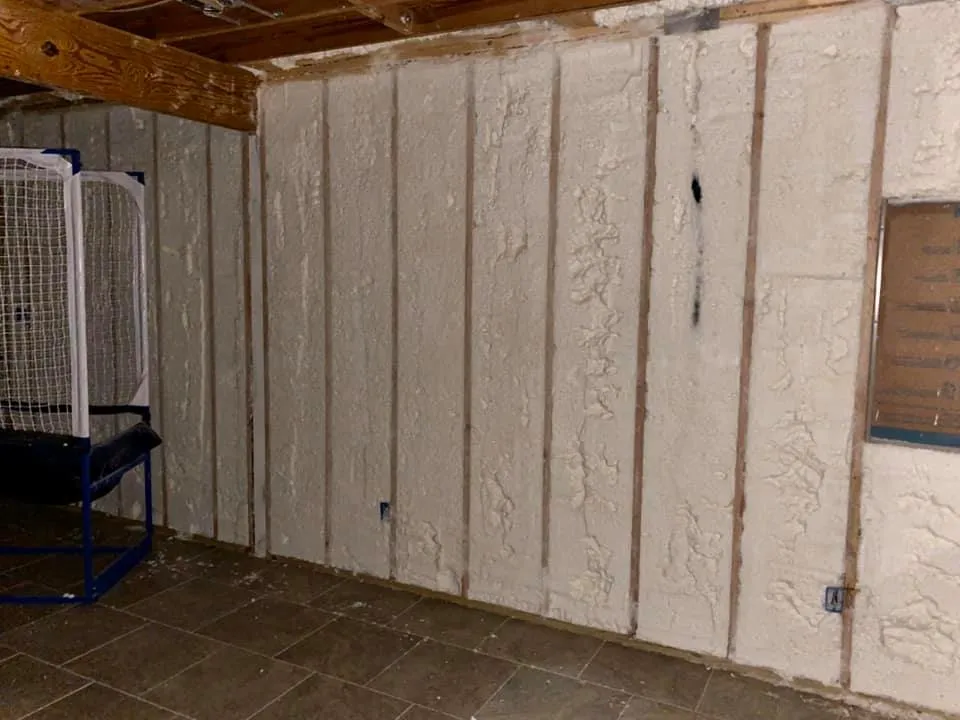Maintaining spray foam insulation requires regular visual inspections every 6-12 months, monitoring for cracks, discoloration, or pest intrusion, and addressing any issues immediately to preserve thermal performance. Properly installed spray foam can last 80-100 years with minimal maintenance, but neglecting routine checks can lead to energy loss and structural problems that cost significantly more to repair than prevent.
The key to long-term spray foam performance lies in understanding what to look for during inspections and knowing when professional intervention becomes necessary. This comprehensive guide provides the practical knowledge needed to protect your insulation investment and maintain optimal energy efficiency throughout your property’s lifetime.
Based on extensive field experience with thousands of installations across diverse climate conditions, the maintenance strategies outlined here address real-world challenges that property owners face when caring for their spray foam insulation systems.
Understanding Spray Foam Insulation Longevity
Spray foam insulation stands apart from traditional insulation materials due to its exceptional durability and self-sealing properties. Unlike fiberglass or cellulose that can settle, compress, or absorb moisture, properly applied spray foam maintains its structural integrity for decades.
The longevity of spray foam depends heavily on installation quality and environmental conditions. Closed-cell foam typically outlasts open-cell varieties due to its superior moisture resistance and structural strength. However, both types require systematic monitoring to identify potential issues before they compromise performance.
Climate variations significantly impact maintenance requirements. Properties in humid regions need more frequent moisture assessments, while those in extreme temperature zones require careful monitoring for thermal expansion effects. Understanding your local environmental factors helps establish appropriate inspection schedules.
Essential Inspection Techniques and Schedule
Regular inspections form the foundation of effective spray foam maintenance. Visual assessments should occur twice yearly, ideally during spring and fall when temperature fluctuations are moderate and conditions allow for thorough examination.
During inspections, examine all accessible foam surfaces for signs of deterioration, including cracks, gaps, discoloration, or unusual odors. Pay particular attention to areas where foam meets different building materials, as these junctions often experience the most stress from thermal movement.
Document findings with photographs and notes to track changes over time. This documentation proves invaluable when determining whether observed changes represent normal aging or require professional attention.
Inspection Frequency by Location:
| Location | Inspection Frequency | Key Focus Areas |
|---|---|---|
| Attic Spaces | Every 6 months | UV exposure, temperature extremes |
| Basement/Crawl Space | Every 6 months | Moisture intrusion, pest activity |
| Wall Cavities | Annual | Settling, thermal bridging |
| Commercial Buildings | Quarterly | High-traffic impact areas |
Identifying Common Issues and Warning Signs
Recognizing early warning signs prevents minor issues from developing into costly problems. Discoloration often indicates UV exposure or chemical interaction, while soft or spongy areas suggest moisture intrusion or incomplete curing during initial application.
Cracks typically develop along stress points where building materials expand and contract at different rates. Small hairline cracks may seal naturally, but gaps exceeding 1/8 inch require immediate attention to prevent air leakage and thermal bridging.
Unusual odors warrant immediate investigation, as they may indicate chemical breakdown, mold growth, or pest infestation. Fresh chemical smells months after installation suggest ongoing curing issues that require professional assessment.
Common Warning Signs Assessment:
| Warning Sign | Severity Level | Recommended Action |
|---|---|---|
| Hairline cracks (<1/8″) | Low | Monitor for growth |
| Gaps >1/8″ | Moderate | Professional repair within 30 days |
| Discoloration | Variable | Assess cause immediately |
| Soft/spongy texture | High | Professional evaluation required |
| Chemical odors | High | Stop use, ventilate, call professionals |
Maintenance Tasks for Optimal Performance
Routine maintenance tasks extend spray foam life and maintain energy efficiency. Keep foam surfaces clean by removing debris, dust, and organic matter that could harbor pests or promote mold growth. Use gentle cleaning methods to avoid damaging the foam structure.
Protect exposed foam from UV radiation using appropriate coverings or coatings designed for spray foam applications. UV exposure degrades foam surfaces over time, creating entry points for moisture and pests.
Maintain proper ventilation in spaces containing spray foam to prevent moisture buildup and ensure adequate air circulation. This proves particularly important in enclosed areas like crawl spaces where humidity can accumulate.
Bonus Tip: Create a maintenance log that tracks inspection dates, findings, and actions taken. This documentation helps identify patterns and provides valuable information for insurance claims or warranty issues.
Professional Maintenance Requirements
While property owners can handle basic inspections and minor maintenance tasks, certain situations require professional expertise. Complex repairs, extensive damage assessment, and warranty-related issues should always involve qualified insulation professionals.
Schedule professional inspections every 3-5 years, even when no obvious problems exist. Professionals can identify subtle issues that untrained eyes might miss and provide preventive treatments that extend insulation life.
Professional maintenance becomes essential after severe weather events, structural modifications, or when installing new HVAC systems. These situations can create stress points or alter building dynamics in ways that affect insulation performance.
According to the North American Insulation Manufacturers Association, properties with professionally maintained spray foam insulation retain 95% of their original R-value after 20 years, compared to 70-80% for properties relying solely on owner maintenance.
Environmental Factors and Regional Considerations
Climate conditions significantly influence maintenance requirements and inspection priorities. High-humidity environments accelerate potential mold growth and require more frequent moisture assessments. Areas with extreme temperature variations need increased attention to thermal expansion effects.
Coastal properties face additional challenges from salt air exposure, which can interact with certain foam formulations. Desert climates present UV exposure concerns and require protective measures for any foam exposed to direct sunlight.
Regional building codes may specify particular maintenance requirements or inspection intervals for spray foam installations. Familiarize yourself with local regulations to ensure compliance and maintain warranty coverage.
Bonus Tip: Install humidity monitors in areas with spray foam insulation to track environmental conditions and identify potential moisture issues before they become visible problems.

Troubleshooting Performance Issues
When spray foam insulation appears to underperform, systematic troubleshooting helps identify root causes. Begin by verifying that HVAC systems operate correctly, as equipment problems often masquerade as insulation failures.
Check for air leaks around windows, doors, and penetrations that might bypass the insulation system. These thermal bridges can significantly impact energy efficiency while creating the impression of insulation failure.
Evaluate whether performance issues coincide with seasonal changes, recent construction activities, or equipment modifications. This timing information helps narrow potential causes and guides appropriate remedial actions.
Performance Issue Diagnosis:
| Symptom | Likely Cause | Investigation Method |
|---|---|---|
| Increased energy costs | Air leaks or thermal bridges | Thermal imaging scan |
| Uneven temperatures | Installation gaps | Visual inspection |
| Moisture problems | Vapor barrier issues | Moisture meter testing |
| Pest intrusion | Foam damage or gaps | Entry point identification |
Professional Spray Foam Services for Long-Term Success
- Quality Insulation Solutions for Every Property: Stellrr Insulation & Spray Foam provides comprehensive services designed to maximize your insulation investment and ensure optimal long-term performance.
- Residential Spray Foam Insulation: Complete installation and maintenance services for homes, including open-cell and closed-cell applications tailored to your specific climate requirements and energy efficiency goals.
- Commercial Spray Foam Insulation: Professional-grade insulation solutions for commercial properties, with maintenance programs designed to protect your investment and maintain consistent energy performance.
- Insulation Removal: Safe removal of damaged or underperforming insulation materials, preparing spaces for upgraded spray foam installation with proper surface preparation and contamination remediation.
- Crawl Space Insulation: Specialized moisture control and insulation services for challenging below-grade spaces, including vapor barriers and humidity management systems.
Things to Consider Before Making Maintenance Decisions
Evaluate the age and condition of your current spray foam installation before implementing maintenance strategies. Newer installations may require different attention than systems approaching their mid-life point.
Consider your property’s specific environmental exposures when planning maintenance schedules. Buildings in harsh climates or high-exposure locations benefit from more frequent professional assessments.
Budget for both routine maintenance costs and potential repair needs when planning long-term property care. Preventive maintenance costs significantly less than major repairs or complete reinstallation.
Bonus Tip: Maintain detailed records of your spray foam installation, including manufacturer specifications, installer information, and warranty terms. This documentation proves essential for warranty claims and helps professionals provide more effective service.
Research indicates that properties with documented maintenance programs experience 40% fewer insulation-related issues and maintain energy efficiency ratings 15% higher than those without structured maintenance approaches.
Common Questions About Spray Foam Maintenance
How often should I inspect my spray foam insulation?
Conduct basic visual inspections every six months, focusing on accessible areas for signs of damage, discoloration, or pest activity. Schedule professional inspections every 3-5 years for comprehensive assessment.
What cleaning products are safe for spray foam?
Use mild soap and water solutions for routine cleaning. Avoid harsh chemicals, solvents, or abrasive materials that can damage foam surfaces or create chemical reactions.
Can I repair small cracks myself?
Minor hairline cracks often self-seal, but gaps exceeding 1/8 inch require professional attention. Attempting DIY repairs with incompatible materials can worsen problems and void warranties.
How do I protect exposed spray foam from UV damage?
Apply UV-resistant coatings designed specifically for spray foam, or install physical barriers like drywall or protective panels. UV exposure causes surface degradation that creates entry points for moisture and pests.
When should I consider spray foam replacement?
Consider replacement when foam shows extensive cracking, significant discoloration, loss of adhesion, or persistent odors. Generally, properly maintained spray foam lasts 80-100 years, making replacement rarely necessary.
Maximizing Your Insulation Investment
Proper maintenance ensures spray foam insulation delivers maximum energy efficiency and longevity throughout its service life. Regular inspections, prompt attention to warning signs, and professional maintenance when needed protect your investment while maintaining optimal indoor comfort.
The combination of owner vigilance and professional expertise creates the most effective maintenance approach. Understanding what to look for and when to seek professional help prevents minor issues from developing into major problems that compromise insulation performance.
Evaluate your specific property conditions, local climate factors, and maintenance capabilities to develop a customized care program that ensures long-term success.
Want to see how we’re helping more homeowners and businesses improve insulation performance across the region? Read more about our expanded spray foam services.
Get Expert Insulation Guidance
Protect your insulation investment with professional maintenance and inspection services designed to maximize performance and longevity. Whether you need routine maintenance, damage assessment, or complete insulation solutions, expert guidance ensures optimal results.
Contact Stellrr Insulation & Spray Foam at (512) 710-2839 or info@stellrr.com for comprehensive insulation services and maintenance programs tailored to your property’s specific needs. Professional expertise combined with quality materials delivers the energy efficiency and comfort your property deserves.
Frequently Asked Questions
How long does spray foam insulation typically last before requiring replacement?
Properly installed and maintained spray foam insulation lasts 80-100 years without requiring complete replacement. Closed-cell foam generally outlasts open-cell varieties due to superior moisture resistance, with most performance issues resulting from installation defects or neglected maintenance rather than natural aging.
What are the signs that my spray foam insulation needs professional repair?
Contact professionals immediately for gaps larger than 1/8 inch, soft or spongy foam texture, persistent chemical odors, or significant discoloration across large areas. Other warning signs include visible mold growth, pest intrusion evidence, or noticeable energy cost increases despite normal HVAC operation.
Can moisture damage spray foam insulation and how do I prevent it?
Moisture can compromise spray foam performance, particularly with open-cell formulations that are more permeable than closed-cell varieties. Prevent issues by maintaining proper ventilation, addressing leaks immediately, monitoring humidity levels, and installing vapor barriers where required by building codes.
Is it normal for spray foam insulation to have a slight odor years after installation?
Fresh spray foam should develop minimal odor within 24-48 hours after proper installation and curing. Persistent odors months or years later indicate potential problems such as incomplete curing, moisture infiltration, or chemical breakdown requiring professional investigation.
How much does professional spray foam maintenance typically cost compared to potential repair expenses?
Professional maintenance inspections cost $200-500 annually while major repairs range from $2,000-10,000 depending on damage extent. Preventive maintenance represents approximately 2-3% of original installation costs but prevents repair expenses that can exceed 50% of replacement value.





